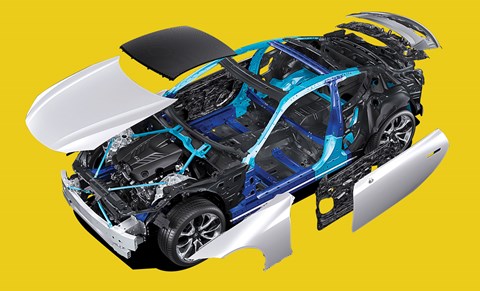► New Lexus platform examined
► ‘GA-L’ architecture for future product
► Destined for Lexus LC 500, due 2017
The Lexus blueprint is in the shredder, as Akio Toyoda, Toyota boss and grandson of the company’s founder, strives to make his premium brand famous for more than just precision build, reliability, whining hybrids and engineers who make cars handle in spite of – not because of – the chassis raw materials. And this is the first strike in that mission: the all-new GA-L architecture, underpinning this 467hp LC 500 coupe and all future Lexus crossovers and saloons from IS upwards.
If the PR-hype is to be believed Toyoda’s epiphany dates back to the 2011 Pebble Beach Concours d’Elegance, where he unveiled the fourth-generation GS saloon with its Samurai chain-mail grille, just as Lexus’s 11-year hegemony as the pre-eminent US luxury car brand was coming to an end.
Toyoda appointed himself ‘chief branding officer and master driver for Lexus’ (arguably he needs a rebrand on that job title), but his passion for racing and dynamics has underpinned GA-L: global architecture – luxury vehicles.
Lexus rolls out the big guns: new 467bhp LC 500 coupe revealed in Detroit
The 5.0-litre V8 is pushed back to a front/mid-engined position, weight distribution is 52:48 front:rear, and the body structure is, Lexus claims, more torsionally rigid than the all-carbonfibre LFA supercar’s.
Extensive use of high-strength steels in the sills, lower ‘A’ posts, upper ‘B’ posts and cross beams enhances rigidity. Steel floorpan and inner wing pressings keep weight low down for a better centre of gravity. And while the rakish, 2+2 coupe’s bonnet, wings and outer door skins are aluminium, the latter feature lightweight carbonfibre reinforced plastic inners. Optional carbonfibre roof can replace a standard glass panel.
The coupe also bloods an innovative multi-link front suspension set-up, specially engineered and packaged so as to preserve the lines of the 2012 LF-LC concept which spawned the new coupe.
With a likely £90,000 price when UK sales start in 2017, the LC 500 will compete with Maserati’s GranTurismo and the BMW M6. It should sound riotous on its way to 62mph in less than 4.5sec, thanks to a dual-snorkel induction system, active baffles that open in Sport and a sound generator kicking in under acceleration. Expect a similar technical and aural overhaul for the hybrid: the story should be on www.carmagazine.co.uk as you read this.
If it pans out as Lexus intends, GA-L should provide the platform for 100,000 annual sales in Europe by 2020. And the master driver will have started unlocking the brand’s potential.

1) Concept lines
Bespoke multi-link ‘raft’ front suspension created to save concept’s low bonnet. Two cast aluminium upper mounts double up as anchors for engine bay braces. Double ball joints on upper/lower control arms manage steering inputs and road feedback, while isolating spring/damper feedback.
2) Just the 10 gears
World’s first 10-speed auto sticks with torque convertor: dual-clutch not deemed smooth enough at low speeds. Said to be lighter, smaller and more efficient than current eight-speeders; employs ‘fuzzy’ logic to tailor gearshifts depending on whether driver is a granny or a hooligan.
3) Sorted chassis
52:48 weight distribution from front/mid-engine layout, with 5.0-litre V8 aft of the front axle line and the battery relocated to the boot. Driver’s hip-point engineered to be as close as physically possible to the car’s centre of gravity for optimum feel and balance.
4) Let it blow
Vents ahead of each wheel are functional: front pair feed air onto the brakes and for additional transmission cooling. Rear vents manage turbulent air away from the back wheels for additional high-speed stability.
Read more from the March 2016 issue of CAR magazine